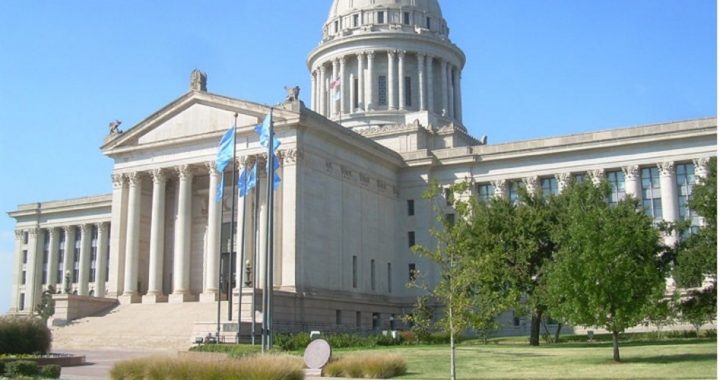
Oklahoma Republican Governor Mary Fallin has announced that the Ten Commandments monument at the Capitol will remain, despite the ruling by the Oklahoma Supreme Court that it violates the state constitution and must be removed.
Fallin’s action came as the state’s Attorney General Scott Pruitt, also a Republican, asked the Oklahoma Supreme Court to reconsider its 7-2 decision ordering its removal.
Pruitt observed,
Quite simply, the Oklahoma Supreme Court got it wrong. The court completely ignored the profound historical impact of the Ten Commandments on the foundation of Western law. Furthermore, the court’s incorrect interpretation of Article 2, Section 5, contradicts previous rulings of the court.
Pruitt asserted that his office will file a petition with the court for a rehearing “in light of the broader implications of this ruling on other areas of state law.”
Governor Fallin explained, “Oklahoma is a state where we respect the rule of law, and we will not ignore the state courts or their decisions. However, we are also a state with three coequal branches of government.”
The court’s decision also brought criticism from outside the legislative and executive branches of state government. The Reverend Paul Coakley, the archbishop of the Archdiocese of Oklahoma City, argued,
The Supreme Court’s decision to remove the Ten Commandments monument from the Capitol grounds ignores its historical significance in the formation of our state and as an ancient law code having prominence at the place where lawmakers work to enact wise and just laws.
The action of the state’s high court, in response to a lawsuit brought by the American Civil Liberties Union (ACLU) on behalf of three plaintiffs, has caused a storm of protest in the Sooner State, with legislators calling for the impeachment of the seven justices who ruled against the monument. While Oklahoma is a solidly Red state, with the Republicans in control of both chambers of the legislature and in charge of the executive branch, eight of the judges were appointed by liberal Democrat governors.
Other legislators are exploring repeal of the portion of the state constitution, Article 2, Section 5, cited by the High Court in its controversial decision. Critics of the section in question contend that it is a version of the so-called Blaine Amendment, enacted in 1875, out of concern over the rising tide of Roman Catholic immigration into the country. Congressman James Blaine authored the amendment, which passed the U.S. House 180-7, but failed the required two-thirds vote in the Senate. However, many states opted to include a version of the “Blaine Amendment” in their state constitutions. Oklahoma, which entered the Union in 1907, was one of a group that eventually included 38 states that incorporated some variation of the wording of the amendment in their fundamental law.
Oklahoma’s version of the Blaine Amendment reads, “No public money or property shall ever be appropriated, applied, donated, or used, directly or indirectly, for the use, benefit, or support of any sect, church, denomination, or system of religion, or for the use, benefit, or support of any priest, preacher, minister, or other religious teacher or dignitary, or sectarian institution as such.”
In its lawsuit, the ACLU contended, and the court agreed, that the placement at the Capitol of a monument to the Ten Commandments violates this wording.
However, the monument was privately funded by Republican State Representative Mike Ritze. On January 8 of this year, workers replaced the 2,400-pound granite Ten Commandments monument on the grounds of the Capitol in Oklahoma City. The original was destroyed last fall when a man deliberately rammed his car into it. Ritze, who paid $10,000 for the original monument, commented, “While the destruction of the original monument was tragic, this replacement is identical in every respect and we look forward to its standing the test of time.” Ritze noted that the Ten Commandments are an important component of the foundation of the laws and legal system of the federal government as well as the state of Oklahoma.
The original monument was erected in 2012 after Ritze’s bill passed the Republican-controlled legislature, and was signed into law by then-Governor Brad Henry, a Democrat.
The monument generated opposition from the beginning, however. The lead plaintiff in the lawsuit, Bruce Prescott of Norman, is an ordained Baptist minister, and the executive director of the liberal group which calls itself Mainstream Oklahoma Baptists. Although Prescott at one time hosted a weekly radio program in Oklahoma billed as having a Christian bent, he generally promoted liberal political views, and once even provided a forum for an avowed witch.
The ACLU’s suit contended that the monument allowed the state government “to use its vast power and influence to tell you what you should believe.”
Then, the New York-based Satanic Temple said the display of the Ten Commandments opened the door for them to seek their own display of the devil. The satanic group even unveiled a design for a 7-foot-tall statue of Satan as a goat-headed figure with horns, wings, and a long beard. That was followed by proposals from a Hindu leader in Nevada, among others.
Supporters of the monument have argued that the Ten Commandments monument does not violate the state constitution because the money for its erection was privately donated, and its placement at a location where laws are made accomplishes a historical purpose. No sect or “system of religion” will use the monument, and its erection does not provide “support” for any official of any religion.
Some in Oklahoma have even argued that the portion cited by the state constitution is a relic of an “anti-Catholic” era, and is intended mostly to prevent state funding of parochial schools. Actually, the Blaine Amendment is worded somewhat differently from the proposal by Blaine in 1875. The actual Blaine Amendment is much more explicit in its requirement that no state monies be used for religious schools: “No money raised by taxation in any state for the support of public schools, or derived from any public fund therefor, nor any public lands devoted thereto, shall ever be under the control of any religious sect, not shall any money so raised or lands so devoted be divided between religious sects or denominations.” This wording is not found in Article 2, Section 5, of Oklahoma’s Constitution, but even under the wording of the original Blaine Amendment, it is difficult to grasp how the Oklahoma Supreme Court concluded that the monument violated the state constitution.
And, when one considers the preamble to the Oklahoma State Constitution, “Invoking the guidance of Almighty God,” one must wonder just how is that guidance for a system of government to be found? The Ten Commandments would be an obvious source of guidance, making a monument to those commandments appropriate on the grounds of the Oklahoma State Capitol.
Photo of Oklahoma state capitol: Caleb Long



